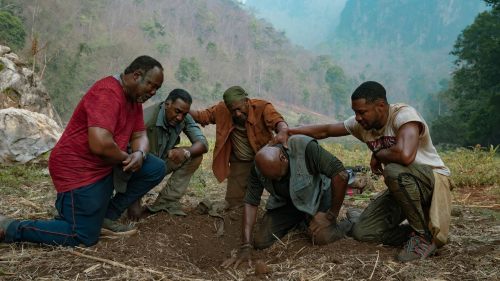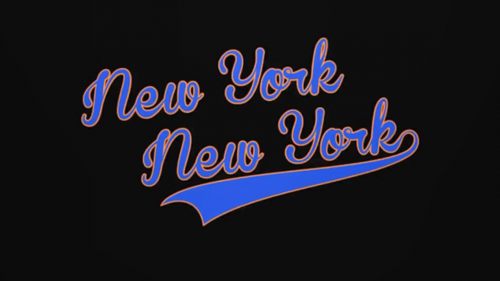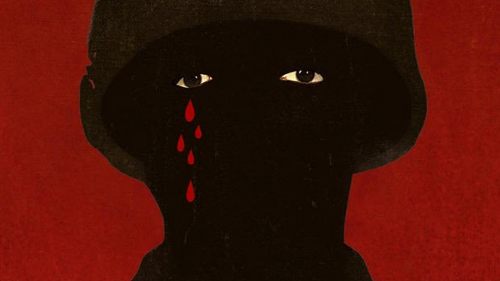Diamonds in the Watermelon Patch: Spike Lee’s BAMBOOZLED
In honor of Sausage Party, which you can buy tickets for here, we’re launching a week of articles focused on controversial films in atypical genres and formats.
Spike Lee has repeatedly been labeled a professional troublemaker; a shit starter, a rabble rouser. Upon exiting the world premiere of Lee’s landmark work of American cinema, Do the Right Thing, Roger Ebert remembers:
One American critic was so angry she chased me to the exit to inform me, “This film is a call to racial violence!” I thought not.
The truth is: Lee isn’t so much interested in instigating as he is in initiating. The Atlanta-born/Brooklyn-bred filmmaker wants to begin a conversation - to have the first word, but not necessarily the last. There’s a distinct reason Do the Right Thing ends with divergent quotations from Martin Luther King Jr. and Malcolm X. We’re supposed to wander out of the darkened theater with both sides of a discussion bubbling in our brains; percolating to the point that our own point of view boils over and needs to be shared with those around us. The scene Ebert describes is one of success. Nonetheless, because Lee is black and approaching issues of race, oppression and the violence societal divides generate, he is labeled “angry” or “irritated”. As our own Film Crit Hulk points out in his superlative dissection of this truly special film (and make no mistake, Do the Right Thing is one of the greatest goddamn movies ever made), Lee “blasts the audience with bright color, humor, anger, music and stark ideas in equal measure*”. Though Lee may be fascinated with the melting pot of the American Experiment and the innate communal friction that comes along with it, his true love is cinema and the boundless possibilities the medium presents to those who want to utilize it as a tool for self-expression and dialogue.
Taking another quote from Malcolm X as inspiration**, Lee’s 2000 satire, Bamboozled, approaches the labels, stereotypes and pressures he and other vocal black artists have been slapped with by the media over the years. Bamboozled revolves around a frustrated African American TV scribe, Pierre Delacroix (Damon Wayans), who crafts a contemporary take on a minstrel variety act in order to get himself fired and ultimately expose the commissioning network as being part of a racist conglomerate. Ironically the program, which features black stars donning stark blackface and cartoonish crimson lips, becomes a massive hit. Delacroix’s mind collapses, unable to fathom how he created such a monster, culminating in a blast of deadly rage, the effects of which ripple out amongst society at large. National Lampoon repurposed as American tragedy, in true Lee fashion, Bamboozled not only got folks talking – it also pissed a ton of people off. In the distance, you can almost hear Robert Downey Sr. cheering him on.
Labeled a “dangerous free-for-all” by Stephen Holden in the New York Times and generally dismissed as being overwrought and over-the-top, Lee’s film is as upsetting a comedy as you will ever see. Though no critic wrongheadedly claimed that the movie would incite riots (like David Denby did before Do the Right Thing was even released), opening racial wounds and mining the ugliest corners of America’s history in order to explore how images of blackness are exploited and perverted by the media was sure to get under certain analysts’ skins. Bamboozled climaxes with a devastating mosaic of racist images from our pop past, Lee’s resentment of how black people have been portrayed reaching an all-time high. But again, this indignation isn’t meant to provoke forcefulness, but rather discourse. Open your eyes to the bigoted phantasmagoria you’re subjected to every day, and truly see how an entire people have been distorted in order to fit others’ views and to manipulate yours.
Film curator and critic Ashley Clark penned the definitive analysis of Lee’s film (“Facing Blackness: Media and Minstrelsy in Spike Lee's Bamboozled”), labeling it the “quintessential Spike Lee joint." “I really do think that Bamboozled is Peak Spike," Clark said in an interview with Tribeca last year. "There are certain things that define Spike Lee as a filmmaker: a lack of subtlety, a fondness for caricatures, an interest in very hot-button social issues, formal and technological experimentation. Those things all crash together in Bamboozled." Though cataloguing the movie as the apex of a rather stellar filmography is debatable, Clark is correct in wondering if Bamboozled is possibly the most Spike Lee movie ever made. The auteur’s fascinations swirl together, forming a Molotov cocktail of social satire, ready to be tossed at an establishment of which Lee has always been on the fringes. The fact that a major studio distributed the project is actually astounding in hindsight, as New Line took a gamble on a movie filmed with consumer grade DV that never even tries to meet its audience halfway. Bamboozled demands the viewer commit to Lee’s bitingly acerbic vision, despite it being filmed in a manner aesthetically alien to the average moviegoer.
Lee’s application of digital video is not as jarring in 2016 as it was when the film was initially released (thanks to fellow auteurs like Stephen Soderbergh, Michael Mann and David Lynch subsequently stretching the limits of the technology), but it still takes a moment for the viewer’s eye to become acclimated to the grainy, pixelated texture. However, Lee hasn’t changed his cinema-drunk style in order to adapt to the new medium, as one of his trademark mounted dolly shots opens the film. Delacroix addresses us directly, explaining just what “satire” means and how we’ve begun tuning out from the “idiot box” that employs him. Spike Lee has never been a formal realist, but the immediacy of digital lends a counterweight to his usual heightened bravura. Once we’re back on his beloved NYC streets, there’s an almost documentary-like quality to the picture when we’re introduced to Manray (Savion Glover) and Womack (Tommy Davidson), two poverty-stricken street performers doing their own shuck and jive just downwind from the TV station where Delacroix works. This juxtaposition of amplified chic and pedestrian humdrum emphasizes how disconnected the white-dominated writers’ room is from the two struggling artists who tune into the Chris Rock Show at the end of a long, hard day of dancing.
The performances in Bamboozled match the movie’s dissonant visual style. Damon Wayans is one affectation away from doing a hackneyed black stand-up “white guy voice” as the Harvard educated creator, didactically lecturing about how his show is going to be a “wake up call” for America. He’s a self-righteous nightmare person, his soul tarnished by watching years of genuine artistic output get scoffed at by his white overlords. Playing against him are Savion Glover and Tommy Davidson – both all naturalism and raw charisma. Glover especially is downright electrifying to watch. An early moment where he’s made to get up on a table and dance in an executive’s office should be soul crushingly demeaning, but Glover instead transforms it into a mind-blowing “star is born” bit of improv theater. Jada Pinkett Smith is incredible as the movie’s conscience – portraying Delacroix’s dutiful assistant, Sloan, as an objector who can’t help but laugh off how offensive her boss’ scheme truly is. Nevertheless, she buys into the ridiculousness of it all, adding a viable backbone to this unwieldy media monstrosity. Mos Def plays Sloan’s gangsta rap brother, Big Blak Afrika (don’t call him by the “slave name” their parents gave him), mobilizing his people in the studio against the two “coons” who are keeping their true black art off the airwaves. Lee has presented a spectrum of blackness with his characters, poking and prodding African American identity while only occasionally letting them slip into caricature in order to make a point.
One would imagine that it’s difficult to play an avatar for cultural misappropriation, but Michael Rapaport is more than game. His racially ignorant TV Exec, Thomas Dunwitty, is alternately uproarious and upsetting every time he’s onscreen. “You know, I grew up around black people my whole life. Truth be told, I probably know niggers better than you,” he says to Delacroix at one point, dressing the disgruntled creator down. “I don't give a goddamn what that prick Spike Lee says. Tarantino was right. Nigger is just a word.” Outside of publicly putting the Jackie Brown director on blast (illustrating a beef Spike has held over QT’s own usage of the word “nigger” in his work), Lee uses Rapaport as an example of everyday white minstrelsy – the co-opting of black culture without contemplation of how it’s been (and currently remains) perverted by his own race. It’s an incredibly insightful exaggeration that illustrates some of the movie’s greater points (albeit via Clark’s aforementioned jackhammer subtlety). Dunwitty is essentially the white dude who watches Chappelle Show and thinks it’s cool to use the word “nigger” because he’s got black friends, never taking into account that skits like “The Niggar Family” are acts of full-scale cultural subversion. He’s the erosion of racial identity without consideration of context or consequence.
“Mantan: The New Millennial Minstrel Show” is a fully realized horror spectacle, rooted in the awful Ghosts of Entertainment’s Past, right down to the blonde directors and the old fashioned methods it’s stars use to apply their blackface and bright red lips. There’s no room for nuance when crafting a variety hour that literally capitalizes on everything racist and disgusting that’s ever graced a stage. The bigger Lee goes, the better, and the DV helps bring a real sense of Brechtian dramatics, the fourth wall falling and allowing us to obtain front row seats at the most miserable show to ever grace an Alabama watermelon patch. It’s brilliant, arresting filmmaking, employing an emerging technology in a fashion that bolsters the movie’s already dense themes through visual experimentation.
There are moments when Lee’s jokes fall flat on their faces. Faux commercials for sponsors Timmi Hillnigger (figure it out on your own) and Da Bomb Malt Liquor (“It makes you get your freak on”) are absolute forehead slappers. Nevertheless, these somewhat juvenile attempts at humor can be forgiven when taken as minor missteps in a rather magnificent whole. Bamboozled remembers our terrible past while also commenting on the present and predicting the future. Lee isn’t so much sermonizing as he is joking about his own observations regarding the ever-evolving state of media and how it constantly condescends and demonizes blackness. By the time we reach the movie’s violent conclusion, it’s hard not to view Bamboozled as prophetic in an age where “thugs” are beaten to death by “scared” police, the caught red-handed Facebook videos emblazoned upon nightly news broadcasts as we helplessly plea for more regulation within our militarized force. The best satire often becomes indistinguishable from reality, and as we sit on the precipice of possibly electing a New York businessman who calls for the full-scale eviction of immigrants and receives endorsements from neo-Nazi groups, it’s not completely outside the realm of imagination that a large section of America would watch something like “Mantan” and not only find it acceptable, but knee-slappingly hilarious as well. Bamboozled is a masterwork because it’s not only ahead of its time, but scarily prophetic. We’ve all been hoodwinked by a media that encourages us to think that hate crimes and the marginalization of POC are beyond our control. It’s time to wake the fuck up and start talking about it.
*Capitalize on your own for max effect.
**”Ya been took! Ya been hoodwinked! Bamboozled! Led astray!”



